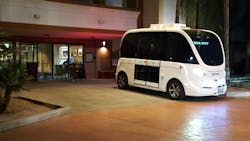Autonomous passenger shuttle pilot program begins in Peoria, Arizona
Autonomous vehicle pilot program set to launch in Peoria, Arizona in late February
Peoria, Arizona’s city council has approved the funding for a 60-day autonomous vehicle pilot program with Beep, an autonomous mobility technologies company based in Florida.
The program will result in Arizona’s first shared-ride, autonomous shuttle operating on a public street.
“This transportation pilot is a unique experiment for our community,” says Mayor Cathy Carlat.
“We see this as an important step as we seek to understand some of the innovative solutions that exist around the world, and how they bring value to Peoria residents.”
Set to launch on Saturday, Feb. 22, the fully electric, driverless shuttle, which has no steering wheel or pedals, will operate daily from noon to 6 p.m. Using a combination of localization techniques, involving high-powered censors and cameras, the shuttle will operate along a pre-programmed, fixed route.
Capable of holding up to 10 passengers at a time, the ADA accessible shuttle will operate at a maximum speed of 15 miles per hour during the pilot program. There are no fees, pre-screening or appointments required to ride in the shuttle.
An attendant will be onboard at all times to make sure that riders have a pleasant and safe experience, and the Beep Command Center can also communicate with the onboard shuttle attendant at any time.
“We are extremely excited about this opportunity,” says Peoria Public Works Director Kevin Burke. “This is level 5 autonomous technology. It could be a game changer for Peoria transit.”
The goal of the pilot program is to understand the feasibility of using autonomous vehicles for the first and last mile of individual trips made primarily by public transportation. Ridership adoption behaviors and patterns in the city of Peoria will also be captured during the pilot program.
“Peoria’s passion for innovation and sustainability is evident through their vision and leadership on this project,” says Joe Moye, CEO of Beep.
“We are very excited to be a part of this collaboration to offer a safe, green and intelligent mobility solution so Peoria’s residents and visitors can have an even more exciting spring training experience.”
Iris Automation customer granted first BVLOS waiver in South Africa
Iris Automation has announced that its customer, United Drone Holdings (UDH), has been granted the first beyond visual line of sight (BVLOS) drone waiver in South Africa, which allows UDH to conduct long-range commercial flights with vertical take-off and landing (VTOL) aircraft.
The BVLOS flight approval was granted by the South African Civil Aviation Authority (SACAA), thanks to the utilization of the Iris Automation Casia onboard detect-and-avoid system. During live flight operations, Casia showcased its ability to make automated maneuvers to avoid collisions with manned aircraft.
Thanks to this approval, UDH will not need visual observers or ground-based radars when conducting BVLOS flights, so only two crew members are needed to perform these flights.
“Iris Automation’s Casia detect-and-avoid system is a game-changer for this industry and enables countless commercial opportunities,” says United Drone Holdings CEO Sean Reitz.
“I set out to find a solution that regulators trusted and that was also light and practical enough for everyday use. Being able to comply with the strict regulations put in place by the South African Civil Aviation Authority and unlocking BVLOS has allowed us to conduct daily missions.”
Described as a “plug-and-play turnkey solution,” the Iris Automation Casia system detects, tracks and classifies other aircraft and makes informed decisions about the threat they could potentially pose to the UAS. To avoid collisions, Casia triggers automated maneuvers, and alerts the pilot on the ground in command of the mission.
“I’m proud to see that our Casia system has been validated once again by gaining BVLOS approval from the regulator in South Africa, which comes in addition to the multiple permissions our technology has already received in the United States,” says Iris Automation CEO Alexander Harmsen.
“Iris Automation currently has customers operating in a dozen countries around the world and we continue to work closely with global regulators both directly and through our customers.”
UDH uses UAS to perform long-range infrastructure inspection, mapping and surveillance for customers throughout South Africa. The host of one of Africa’s largest drone conferences, UDH also provides certified training, SACAA-approved operations, and equipment supply.
Share your vision-related news by contacting Dennis Scimeca, Associate Editor, Vision Systems Design
SUBSCRIBE TO OUR NEWSLETTERS

